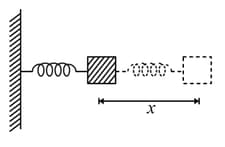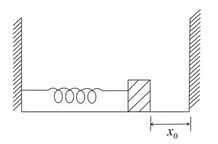The displacement of a particle executing SHM is given by where is in meters and is in seconds. The amplitude and maximum speed of the particle is
Important Questions on Oscillations
The motion of a mass on a spring, with spring constant is as shown in figure.

The equation of motion is given by, with .
Suppose that at time the position of mass is and velocity then its displacement can also be represented as where and are
One end of a spring of force constant is fixed to a vertical wall and the other to a block of mass resting on a smooth horizontal surface. There is another wall at a distance , from the block. The spring is then compressed by and released. The time taken by the block to strike the other wall is

The position co-ordinates of a particle moving in a coordinate system is given by
and
The speed of the particle is:
Assume that the earth is a solid sphere of uniform density and a tunnel is dug along its diameter throughout the earth. It is found that when a particle is released in this tunnel, it executes a simple harmonic motion. The mass of the particle is . The time period of the motion of the particle will be (approximately)
(take , radius of earth )

